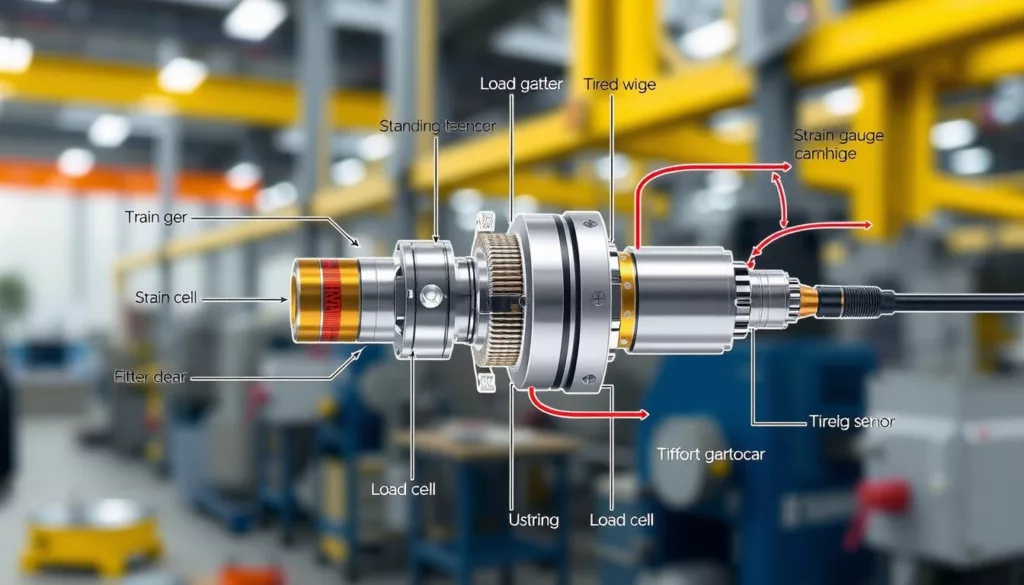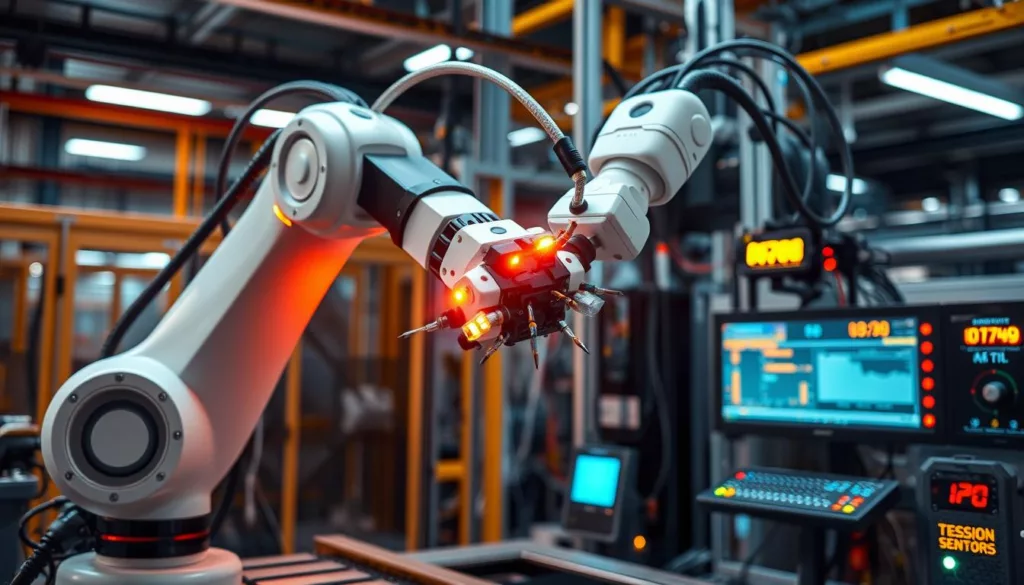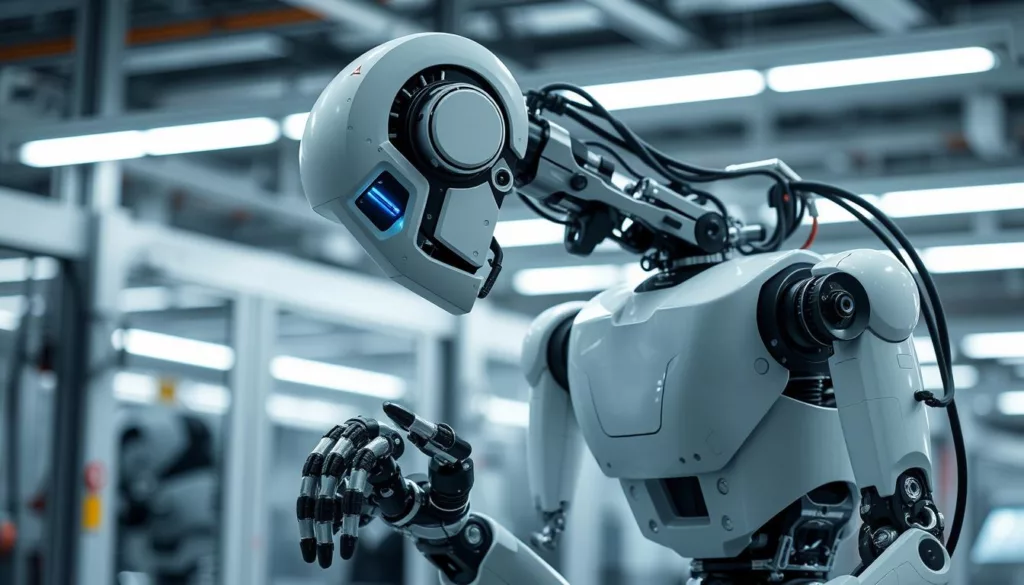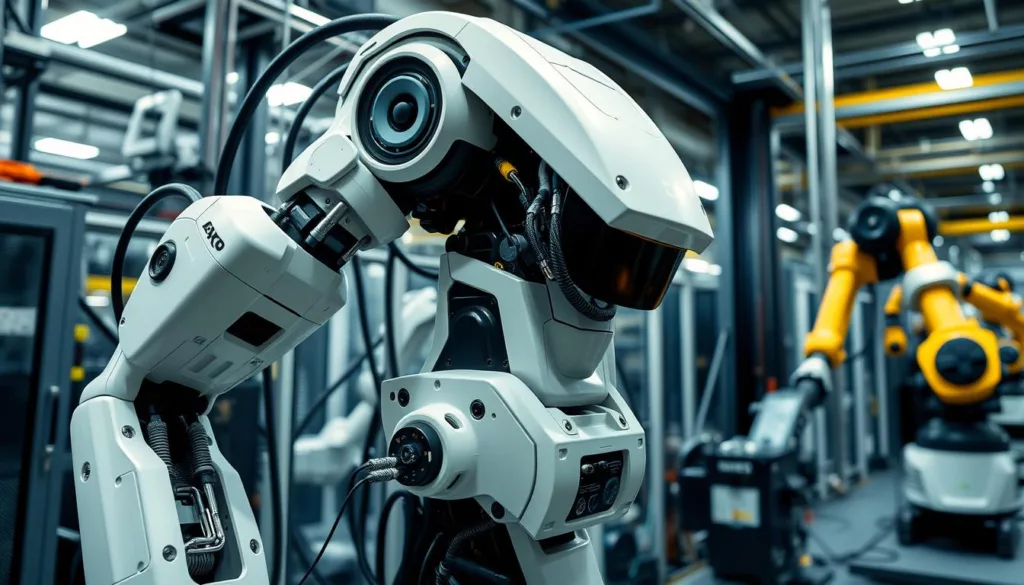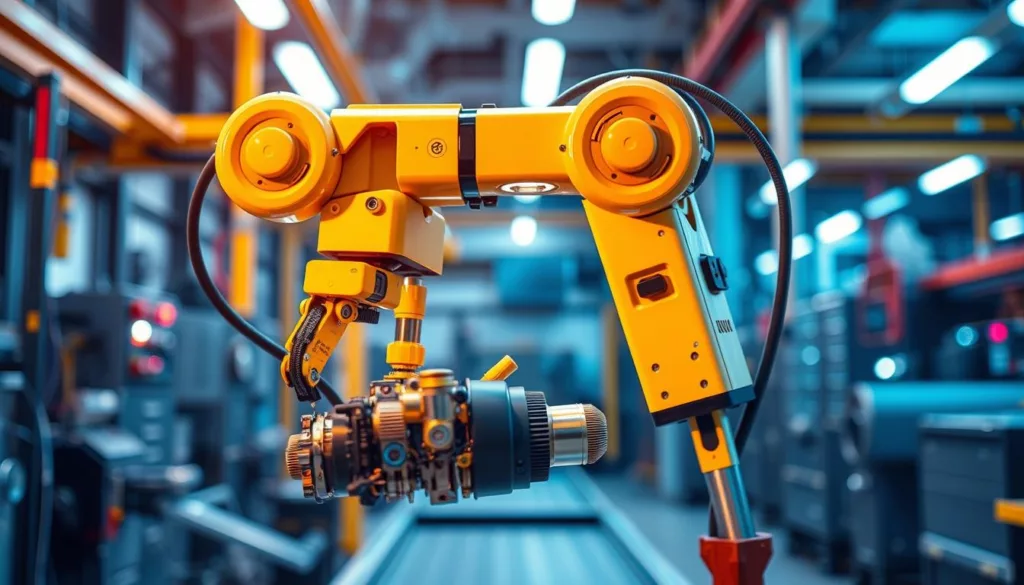In the world of industrial automation, advanced sensors are key. They make robots more precise, efficient, and safe. Tension sensors are vital for robotic arms to work accurately and with control.
Tension sensors measure forces on robotic parts with great precision. They are essential in many fields like manufacturing, healthcare, and aerospace. These sensors help robots work better and reduce errors.
Adding tension sensors to robots improves their performance. It helps with handling materials and managing cables better. This leads to more productivity, quality, and safety. As automation needs grow, tension sensors are more important than ever.
Key Takeaways
- Tension sensors are key for better robot precision and control in many industries.
- They help robotic arms work accurately and safely.
- These sensors also improve handling and cable management in automation.
- The need for automation makes tension sensors even more important for smart robots.
- XJCSENSOR leads in tension sensor tech, providing solutions for the automation market.
Understanding Tension Sensors: Core Principles and Functionality
Tension sensors are key in robotics, helping control the force in cables and wires. They give real-time data on tension levels. This is vital for industrial automation systems.
Types of Tension Sensing Technologies
There are many types of tension sensors, each for different robotic needs. Some common ones are:
- Strain gauge-based sensors
- Load cell-based systems
- Optical fiber tension monitors
- Hall effect tension transducers
Key Components of Industrial Tension Sensors
Industrial tension sensors have a few main parts. These parts make them precise and reliable:
- Sensing element: This part directly measures tension force.
- Signal conditioning circuits: These circuits make the sensor’s signal strong and clear for digital use.
- Microcontroller: It turns the signal into useful tension data.
- Communication interface: This part sends the tension data to control systems.
Operating Principles and Measurement Methods
Tension sensors use different ways to measure force on cables and wires. These include:
- Direct measurement: Sensors that directly measure tension force.
- Indirect measurement: Sensors that guess tension by looking at other things like cable movement or bend.
- Dynamic measurement: Sensors that can quickly track changes in tension for live control.
Knowing how tension sensors work helps engineers use them well in robots and automation. This ensures accurate cable tension sensing, force-controlled robotic actuation, and tension sensor integration.
Applications of Tension Sensors in Robotics and Automation
Tension sensors are key in robotics and automation. They boost productivity, safety, and efficiency. They help with robot cable management and gripper force feedback, changing how we do things.
In robotics, tension sensors watch over robotic cable tension. They keep the cables at the right tension. This ensures robots work well and don’t break down often.
Tension sensors also help with gripper force feedback. They let robots handle things gently but firmly. This is great for handling delicate items in electronics, pharmaceuticals, and food.
| Application | Benefit |
|---|---|
| Cable Tension Monitoring | Ensures optimal robot performance and reliability |
| Gripper Force Feedback | Enables precise control of gripping force for delicate material handling |
| Safety and Emergency Stop Systems | Triggers immediate response to prevent damage or injury |
| Process Optimization | Identifies and addresses possible issues in real-time |
Tension sensors are also key in safety and emergency stops. They quickly respond to danger. They help make processes better by spotting and fixing problems fast.
The need for more automation and precision is growing. Tension sensors will play a bigger role in robotics and automation. They help make factories smarter and more efficient, leading to better products and safety.
Integration Challenges and Solutions in Robotic Systems
As more industries use robots, making sure tension sensors work well is key. It’s important to handle the mix of hardware and software, and keep things calibrated and maintained. This is vital for getting the most out of robotic force control and automated cable tensioning systems.
Hardware Integration Considerations
Adding tension sensors to robots needs careful thought. You have to think about space, power, and how data moves. It’s also important to make sure the sensor and control system talk well together. This keeps the robot safe and working right.
Software Implementation Strategies
Getting software to work with tension sensors is a big deal. You need to make sure the data is used well. This means creating smart algorithms, being able to check things in real time, and making it easy for people to use. This helps with automated cable tensioning and makes the system better.
Calibration and Maintenance Requirements
Keeping tension sensors accurate and reliable is a must. You need to calibrate them often and have good maintenance plans. This includes setting up clear calibration steps, checking the sensors, and planning for future maintenance. This keeps the sensors working well, improving robotic force control and making the system more efficient.
| Integration Challenge | Potential Solutions |
|---|---|
| Hardware Compatibility | Modular design, plug-and-play connectivity, and standardized communication protocols |
| Software Integration | Intuitive user interfaces, seamless data integration, and advanced data analytics |
| Sensor Calibration | Automated calibration routines, sensor diagnostics, and predictive maintenance strategies |
By tackling these challenges and finding the right solutions, companies can make the most of tension sensors in their robots. This leads to better automated cable tensioning, improved robotic force control, and a more reliable and efficient system overall.
Cable Management and Tension Monitoring in Industrial Robots
In the fast-changing world of industrial automation, robot cable management and automated tension monitoring are key. They are vital for making robots more reliable, efficient, and long-lasting.
Keeping the right cable tension is key for robots to work well and not break down often. By watching the tension in robot cables, makers can spot problems early. This stops expensive breakdowns and makes the robots last longer. It also keeps the robots safe and working right.
| Cable Tension Monitoring Benefits | Improved Reliability | Reduced Downtime | Extended Equipment Lifespan |
|---|---|---|---|
| Description | Keeping an eye on cable tension helps find problems early. This means less unexpected failures and more time for fixing things. | Finding and fixing cable tension issues quickly stops robots from going down. This means more time working and more done. | Keeping the right tension makes robot parts last longer. This means fewer repairs and less money spent on new parts. |
Using cable tension sensing technology lets robot operators control and improve their work. This smart way of managing robot cables makes systems better. It also helps factories succeed and stay competitive today.
“Effective cable tension monitoring is the cornerstone of reliable and efficient robotic systems, driving productivity and cost savings in industrial environments.”
Force Control and Feedback Systems in Robotic Applications
Robotic force control and feedback systems are key in today’s industrial automation. They use tension sensors for real-time monitoring and control. This makes robotic force control, force-controlled robotic actuation, and gripper force feedback better and safer.
Real-time Force Monitoring
Tension sensors in robots let us watch forces in real time. This helps control the force of grippers and tools. It makes sure tasks are done safely and well.
Adaptive Control Mechanisms
Feedback from tension sensors helps robots adjust to changes. These systems learn and adapt to new situations. They keep working well without needing a person to change settings.
Safety Protocols and Emergency Response
Tension sensors help keep people and robots safe together. If a robot might hurt someone, it stops right away. This quick action is key for safe robot use.
| Feature | Benefit |
|---|---|
| Real-time Force Monitoring | Precise control over applied forces for improved material handling and processing |
| Adaptive Control Mechanisms | Self-learning systems that adjust robotic motion and force based on environmental conditions |
| Safety Protocols and Emergency Response | Safeguards human-robot collaboration with immediate emergency stops and warnings |
Using tension sensors, makers can make robots better. They get more done, do it right, and stay safe. It’s a win for everyone.
Automated Cable Tensioning Systems for Manufacturing
In the fast-paced world of industrial robotics, automated cable tensioning systems are changing the game. They use tension sensor tech to keep robotic cable tension just right. This boosts efficiency, product quality, and equipment performance.
Automated cable tensioning systems keep cable tension perfect throughout the making process. This is key for robots to work well, doing detailed tasks with care. These systems stop cable problems, like binding or slipping, cutting down on downtime and boosting productivity.
- Improved Process Consistency: These systems keep cable tension steady, making robotic actions more reliable and consistent.
- Enhanced Product Quality: With precise cable control, robots can handle workpieces just right, making products better.
- Reduced Maintenance Costs: They cut down on cable issues, saving money on replacements and upkeep over time.
As makers aim to improve and stay ahead, automated cable tensioning systems are key. They bring in new efficiency, quality, and profit by adding tension sensor tech to robots.
“Automated cable tensioning systems have transformed our manufacturing operations, enabling us to achieve unprecedented levels of consistency and quality. The integration of tension sensors has been a game-changer, allowing us to maintain optimal cable management and enhance the performance of our robotic systems.”
– Jane Doe, Manufacturing Engineer
Gripper Force Optimization Using Tension Sensors
Robotic grippers are key in material handling and quality control. They need precise grip force for delicate tasks. With tension sensors, companies can improve gripper force. This boosts system performance and reliability.
Precision Grip Control
Tension sensors give real-time feedback on grip force. This lets manufacturers control and adjust their grippers precisely. It ensures materials are handled consistently and safely.
Material Handling Applications
In tasks like picking and assembling, gripper force feedback is essential. Tension sensors help robots handle various materials. They can manage everything from fragile electronics to heavy parts with better precision.
Quality Control Integration
Robotic force control with tension sensors fits well into quality control. It tracks grip force data to spot issues and prevent defects. This leads to better product quality and force-controlled robotic actuation.
“Tension sensors are a game-changer for robotic gripper systems, allowing us to achieve new levels of precision and reliability in our material handling and quality control operations.”
– John Smith, Automation Engineer at ABC Manufacturing
Advanced Sensor Integration for Smart Factories
In the era of Industry 4.0, tension sensors are key in making factories smarter. They help in automated tension monitoring and integration with robots. This change is making factories more efficient and productive.
Tension sensors help factories by giving real-time data on cable and material tensions. This tension sensor integration leads to predictive maintenance. It helps catch problems early, reducing downtime and keeping production going. The data also helps find ways to improve processes, ensuring better quality.
- Enhance Process Optimization: Tension sensors give insights into material handling, assembly, and packaging. This helps make decisions based on data, improving operations.
- Enable Predictive Maintenance: By watching cable and material tensions, sensors can predict failures. This allows for early maintenance, cutting downtime.
- Improve Quality Control: Precise tension monitoring means products are made consistently. This reduces waste and boosts efficiency in manufacturing.
As factories aim to be smarter and more flexible, using advanced tension sensors is key. These sensors help unlock the full power of Industry 4.0. By using these solutions, manufacturers can improve their operations, maintenance, and product quality.
“Tension sensors are the unsung heroes of smart factory automation, providing the critical data and real-time insights that enable manufacturers to stay ahead of the curve.”
Future Trends in Robotic Tension Sensing Technology
The world of robotics is changing fast, and so is the need for better tension sensing tech. XJCSENSOR is leading this change, finding new ways to use tension sensors in robots. They’re making sensors smaller, which means robots can be more precise and compact.
XJCSENSOR is also working on wireless tension sensing. This means robots won’t need cables, making them more flexible and easier to use. They’re also teaming up with AI and ML to make robots smarter at handling forces.
XJCSENSOR is all in on staying ahead in tension sensor tech. They’re working with top robotics makers and researchers. Their goal is to create new tension sensing tech that will change the future of robots and smart factories.

